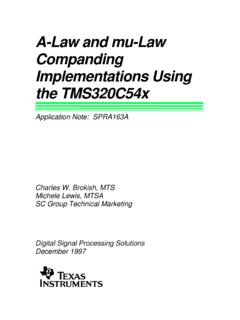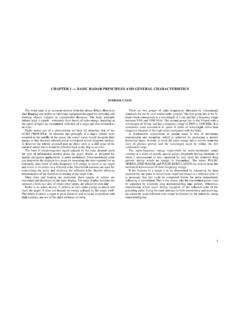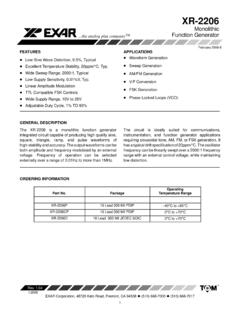Transcription of AMPLITUDE MODULATION AND DEMODULATION
1 Exp. No. : Date: AMPLITUDE MODULATION AND DEMODULATION . AIM. To verify AMPLITUDE MODULATION and DEMODULATION and to calculate the MODULATION index of an AM modulated wave EQUIPMENTS: Modules ACL-AM & ACL-AD. Power supply 20 MHz Oscilloscope. Connecting Links. Frequency counter THEORY. In AMPLITUDE MODULATION the AMPLITUDE of high frequency sine wave (carrier) is varied in accordance with the instantaneous value of the modulating signal. Consider a sine signal vm(t) with frequency f Vm(t) = B Sin (2 f t). And another sine signal Vc(t) is called modulating signal, the signal Vc(t) is called carrier signal. Vc(t) = A Sin (2 F t). The signal Vm(t) is called modulating signal; the signal Vc(t) is called carrier signal. Vary the AMPLITUDE of the carrier vc(t) adding the modulating signal vm(t) to A.
2 You obtain a signal vM(t) AMPLITUDE modulated, which can be expressed by: V m(t) = [A+k B sin(2 f t)] sin(2 F t) = A [1+m sin(2 f t)] sin(2 F t). With k = constant of proportionality The MODULATION index m can be calculated in this way H-h m = --------- 100%. H +h Sri Venkateswara College of Engineering & Technology, Chittoor (Autonomous). BLOCK DIAGRAM FOR AM MODULATION . Sri Venkateswara College of Engineering & Technology, Chittoor (Autonomous). PROCEDURE: 1. Connect SINE OUT post of FUNCTION GENERATOR SECTION (ACL-AM) to the i/p of Balance Modulator1 (ACL-AM) SIGNAL IN Post. 2. Connect o/p of VCO (ACL-AM) RF OUT post to the input of Balancemodulator1 CARRIER IN. post (ACL-AM). 3. Connect the power supply with proper polarity to the kit ACL-AM & ACL-AD, while connecting this; ensure that the power supply is OFF.
3 4. Switch on the power supply and Carry out the following presetting: FUNCTION GENERATOR: LEVEL about ; FREQ. about 1 KHz. VCO: LEVEL about 1 Vpp; FREQ. about 450 KHz, Switch on 500 KHz BALANCED MODULATOR1: CARRIER NULL completely rotated Clockwise or counter clockwise, so as to unbalance the modulatorand to obtain an AM signal with not suppressed carrier across theoutput; OUT LEVEL in fully clockwise. 5. Connect the oscilloscope to the inputs of the modulator post (SIG and CAR) and detect the modulating signal and the carrier signal 6. Move the probe from post SIG to post OUT (output of the modulator), where signal modulated in AMPLITUDE is detected . Note that the modulated signal envelope corresponds to the wave form of the DSB AM. modulating signal. 7. Vary the frequency and AMPLITUDE of the modulating signal, and check the corresponding variations of the modulated signal.
4 9. Vary the AMPLITUDE of the modulating signal and note that the modulated signal can result saturation or over MODULATION . Sri Venkateswara College of Engineering & Technology, Chittoor (Autonomous). MODEL WAVE FORMS. Sri Venkateswara College of Engineering & Technology, Chittoor (Autonomous). DEMODULATION : PROCEDURE: 1. Refer to the FIG. & Carry out the following connections. 2. Connect o/p of FUNCTION GENERATOR section (ACL-AM) OUT post to the i/p of Balance Modulator1 (ACL-AM) SIGNAL IN post. 3. Connect o/p of VCO (ACL-AM) OUT post to the input of Balance modulator 1. (ACL-AM) CARRIER IN post. 4. Connect the power supply with proper polarity to the kit ACL-AM & ACL -AD, While connecting this, ensure that the power supply is OFF. 5. Switch on the power supply and Carry out the following presetting: FUNCTION GENERATOR: Sine LEVEL about Vpp; FREQ.
5 About 1. KHz. VCO: LEVEL about 2 Vpp; FREQ. about 850 KHz, Switch on 1500 KHz. BALANCED MODULATOR1: CARRIER NULL completely rotates Clockwise or counter clockwise, so that the modulator is unbalanced . and an AM signal with not suppressed carrier is obtained across the output: adjust OUTLEVEL to obtain an AM signal across the output whose AMPLITUDE is about 100mVpp LOCAL OSCILLATOR (ACL-AD): 1300 KHz, 2V. Sri Venkateswara College of Engineering & Technology, Chittoor (Autonomous). MODEL WAVE FORMS. Sri Venkateswara College of Engineering & Technology, Chittoor (Autonomous). Result Sri Venkateswara College of Engineering & Technology, Chittoor (Autonomous). Sri Venkateswara College of Engineering & Technology, Chittoor (Autonomous). Exp. No. : Date: FREQUENCY MODULATION AND DEMODULATION .
6 AIM. To verify Frequency MODULATION and DEMODULATION To measure frequency deviation and MODULATION index of FM. EQUIPMENTS. ACL-FM & ACL-FD Kits. Power supply. Oscilloscope. Volt meter. Frequency meter. Connecting Links. THEORY. It is a type of MODULATION in which the frequency of the high frequency (Carrier) isvaried in accordance with the instantaneous value of the modulating signal. Consider a sine wave signal vm(t) with pulse w vm(t) = B sin(w t). and another sine wave vc(t) with upper pulse : vc(t) = A sin( t). The signal vm(t) is called modulating signal, the signal vc(t) is called carrier the frequency of the carrier vc(t) in a way proportional to the AMPLITUDE of the modulating signal vm(t). You obtain a vm(t) frequency modulated diagonal, which canbe expressed by the relation:vm(t) = A sin [ (t)].
7 With (t) instantaneous angle function of vm(t). The instantaneous pulse F(t) of the FM signal by definition: (t) = + K vm(t). The frequency deviation F represents the maximum shift between the modulatedsignal . frequency, over and under the frequency of the carrier: F = . We define as MODULATION index mf the ratio between F and the modulating . frequency f: = . Sri Venkateswara College of Engineering & Technology, Chittoor (Autonomous). BLOCK DIAGRAM. Sri Venkateswara College of Engineering & Technology, Chittoor (Autonomous). PROCEDURE. 1. Connect the power supply with proper polarity to the kit ACL-FM while connecting this;. ensure that the power supply is OFF. 2. Connect the o/p of function generator OUT post to the MODULATION IN of FREQUENCY. MODULATOR MOD IN post.
8 3. Switch ON the power supply and Carry out the following presetting:- FUNCTION GENERATOR: sine wave (JP1); LEVEL about 100mV;FREQ. about 1 KHz. - FREQUENCY MODULATOR LEVEL about 2 Vpp; FREQ. on thecenter; switch on 1500 KHz. the oscilloscope to the output of the modulator FM/RF OUT. frequency deviation _ F can be calculated as follows - From the oscilloscope evaluate FM and Fm, detecting the periods of the respective sine waves - The frequency deviation F is defined as: F = (FM Fm)/2. You can note that if the modulator operates in a linear zone so FM and Fm are over and under the central frequency F of the same quantity F , otherwise this does not occur. value of the MODULATION index mf is calculated by the relation mf = F/f, where f is the frequency of the modulating signal.
9 Observe the FM signal as shown in FIG. observe the FM at lower frequencies apply Sine wave of 1 KHz and 1 Vpp from external function generator to MOD IN post of onboard Function Generator and keep JP4 at 10-100 KHz position and adjust the frequency at about 20-25 KHz and output level of Function generator at 2 Vpp. Sri Venkateswara College of Engineering & Technology, Chittoor (Autonomous). MODEL WAVE FORMS. Sri Venkateswara College of Engineering & Technology, Chittoor (Autonomous). DEMODULATION . PROCEDURE. the o/p of Function Generator (ACL-FM) OUT post to the MOD IN(ACL-FM) post. the o/p of FREQUENCY MODULATOR FM/RF OUT post to the I/p ofRF IN of mixer the power supply with proper polarity to the kit ACL-FM & ACL-FD,while connecting this;. ensure that the power supply is OFF.
10 ON the power supply and Carry out the following presetting: - Frequency Modulator: Switch on 500 KHz; LEVEL about 1 Vpp;FREQ. about 450 KHz. - Frequency demodulator in Foster-Seeley mode (jumpers in FSposition). - Function Generator: Sine wave (JP1); LEVEL about 100mVpp;FREQ. about 1 KHz. - Local Oscillator: LEVEL about 1 Vpp; FREQ. About1000 KHz on(Center). Connect the LOCAL OSCILLATOR OUT to the LO IN of the MIXER and MIXER OUT to the LIMITER IN. post with the help of shorting links. Then connect the LIMITER OUT post to the FM IN of FOSTER- SEELEY DETECTOR and FS OUT to the IN of LOW PASS FILTER. 7. Then observe frequency modulated signal at FM/RF OUT post of FREQUENCY MODULATOR and achieve the same signal by settingfrequency of LOCAL OSCILLATOR at OUT post of MIXER, then observe LIMITER OUT post where output is clear from noise and stabilize around a value of about 8.






